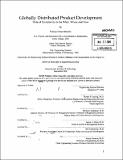Globally distributed product development : role of complexity in the what, where and how
Author(s)
Makumbe, Pedzisayi O
DownloadFull printable version (23.06Mb)
Other Contributors
Massachusetts Institute of Technology. Engineering Systems Division.
Advisor
Warren P. Seering.
Terms of use
Metadata
Show full item recordAbstract
This dissertation presents findings on four elements of the relationship between Global Product Development or Globally distributed Product Development (GPD) and product complexity. I examine this relationship in the context of medical, industrial and electronic equipment developed for American companies outside each development program's home-country. In the first study, I use multinomial logistics models and find that product complexity, specificity, strategic importance and designing firm's capability are directly related to the modes of global product development. These modes are namely global partnerships, captive offshoring and global outsourcing. The more complex products are developed through global partnerships or captive offshores, while the less complex products are globally outsourced. However, the difference in complexity among the three modes varies by region when I divide the world into emerging and mature regions. It is largest in emerging regions and statistically non-significant in mature regions. In the second study, I investigate factors that drive product development to different countries around the world. Using negative binomial models, I find that market size, national capability and number of engineering graduates are directly related to the amount of product development in a particular country, while market growth rate and labor cost are not. I also find that as product complexity increases, the importance of the national capability as a location advantage increases, and that national and firm capability are statistically related to each other. (cont.) In the third study on host national culture, I find that national culture influences the internal team dynamics, but not necessarily where product development is eventually located. Finally, I qualitatively characterize the global product development strategy, organization structure, processes and people, and gather some recommended coordination practices. These include modularizing, not only the product, but the process as well to allow closed-loop monitoring in order to ensure that design expectations were perceived as intended.
Description
Thesis (Ph. D.)--Massachusetts Institute of Technology, Engineering Systems Division, 2008. Cataloged from PDF version of thesis. Includes bibliographical references (p. 168-177).
Date issued
2008Department
Massachusetts Institute of Technology. Engineering Systems DivisionPublisher
Massachusetts Institute of Technology
Keywords
Engineering Systems Division.